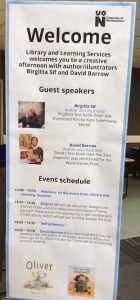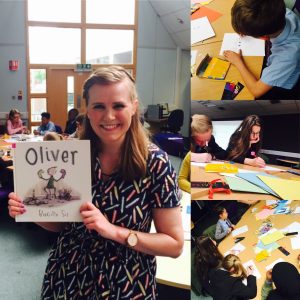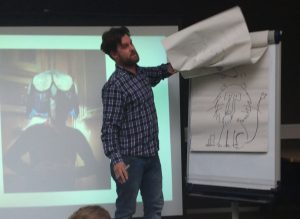 On Monday I was lucky to attend a creative session in the School Experience Library, at Park Campus, University of Northampton. This session, arranged by Academic Librarian, Hannah Rose and Library Learning Services, brought two author illustrators to share with us their approaches to writing and illustrating.
On Monday I was lucky to attend a creative session in the School Experience Library, at Park Campus, University of Northampton. This session, arranged by Academic Librarian, Hannah Rose and Library Learning Services, brought two author illustrators to share with us their approaches to writing and illustrating.
First Birgitta Sif shared with us her journey to being an author illustrator and her process of writing. Birgitta’s  first books was ‘Oliver’, a book about a little boy who was different and how he found friendship. As she read it to us she helped us look more carefully at how the illustrations enriched the text and gave us clues and extra surprises. These included searching for a mouse who present in each picture, finding a character who appeared in the middle of the story actually appears in the previous pictures too and using the text inside the pictures to guide us in the story.
first books was ‘Oliver’, a book about a little boy who was different and how he found friendship. As she read it to us she helped us look more carefully at how the illustrations enriched the text and gave us clues and extra surprises. These included searching for a mouse who present in each picture, finding a character who appeared in the middle of the story actually appears in the previous pictures too and using the text inside the pictures to guide us in the story.
She also showed us how she makes a story by making small sketches to get to know her characters, making tiny prototype books and by drawing the world of the character and the places and people or animals the character encounters. She draws from life and imagination and when she is stuck she goes for walks outside and plays with her children.
 Then Dave Barrow shared his work with us. His first book was ‘Have you seen elephant?’, a book about a game of hide’n’seek with great visual jokes throughout. As Dave read it to us he helped us understand how he had drawn the illustrations by sketching from life, from videos and trying things out for himself.
Then Dave Barrow shared his work with us. His first book was ‘Have you seen elephant?’, a book about a game of hide’n’seek with great visual jokes throughout. As Dave read it to us he helped us understand how he had drawn the illustrations by sketching from life, from videos and trying things out for himself.
Dave also did some live drawing taking ideas from children to give us ideas about how to construct a character through drawing and talking. We could really see how this could lead to imaginative stories as the children talked with Dave. Dave helped them think about how the personality and characteristics of a character could be apparent in a drawing as well how to show clues about the character in the picture so that they didn’t have to be stated in the text. he also showed us how to show the size and scale of a character. He also answered questions about how long it takes to write a story, how many drafts it takes and how sometimes an idea has to be let go to improve the story.
What can we learn?
- Make little prototype books to try out and sequence ideas.
- Draw and sketch from life.
- If you get stuck go outside for a walk.
- Practice drawing if you want to improve.
- Draw a character to get know it before you start to write it into a story.
- Link characteristics of the character with the story you’re going to write.
- Keep drafting and improving.
Some of these are things you might try in school or when you are writing.
As part of the session we also made our own character to take away and maybe write a story about, inevitably, mine was a cat!
Read the story in the university news
Authors encourage pupils to get creative developing characters
.
